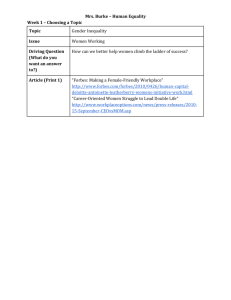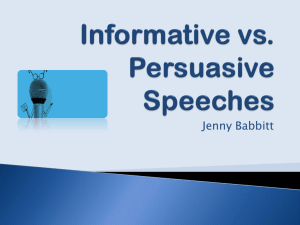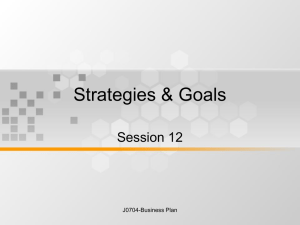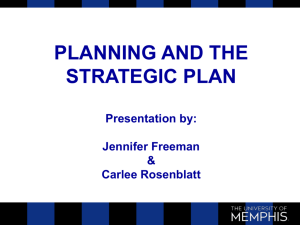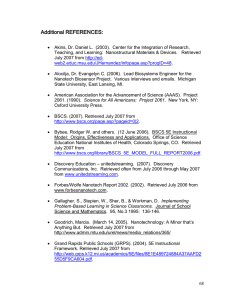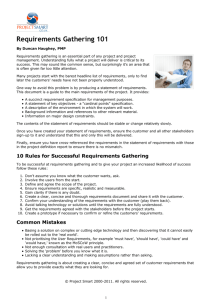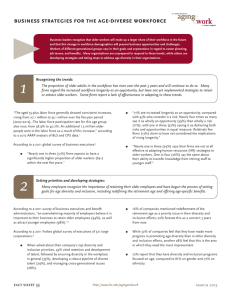Strategic Planning Models
advertisement
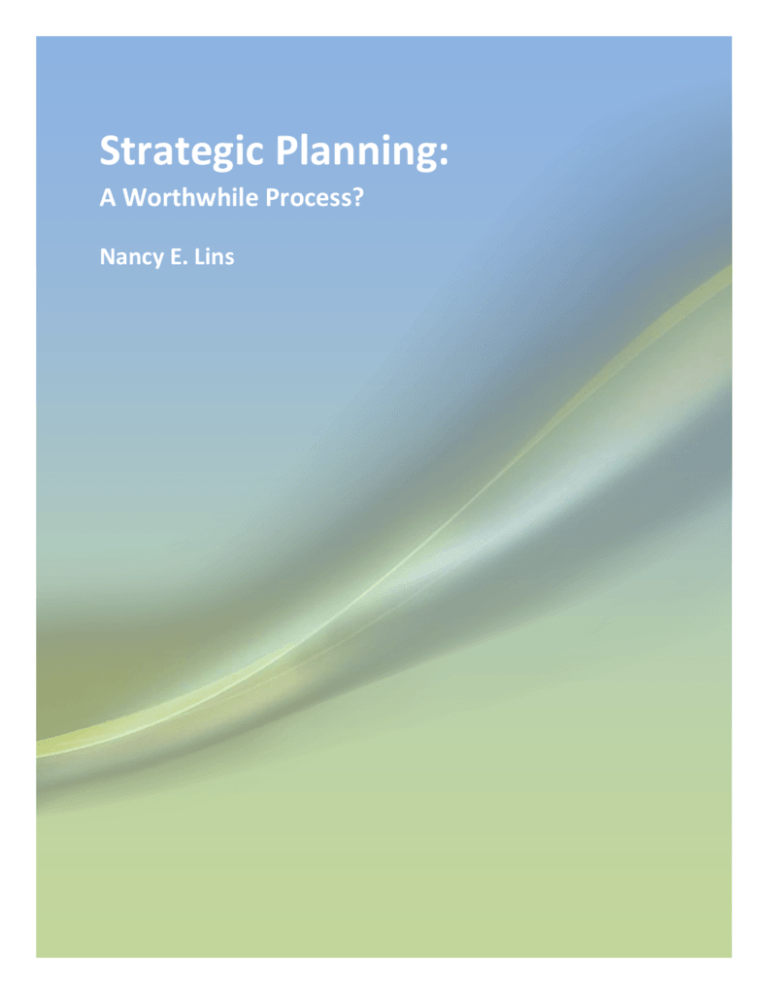
Strategic Planning: A Worthwhile Process? Nancy E. Lins We love process. We hate process. It can be efficient and an effective way to accomplish our goals or the exact opposite – time consuming and a waste of time. And the strategic planning process has been the subject of numerous articles and books. So what makes strategic planning efficient, effective and worthwhile? Not surprising, it is the people involved, the appropriate process, the efficient use of time, the clear view of desired outcomes, the IMPLEMENTATION of actions, the systematic evaluation of progress and the regular review and update of both the plan and action steps. If you are merely writing down a plan of action to do things the way you have already done them, is that strategic planning? Is it necessary or effective? If you are writing the tactics required to manage projects, is that strategic planning or is that project planning? What is strategic planning? We know it is a process. It is a process used by an organization to define its strategy that sets the direction for the organization. Typically a strategic plan is for the whole organization or a large part of an organization, not just a plan for one particular product, project or program. It is a plan for at lease a year but more often for 3-5 years or even more. The big question nowadays is why develop a plan when there is so much uncertainty. The economy, technical advances, changes in laws, and global realities just to name a few of the many constant-changing challenges that face us. Is it really worth it to develop a strategic plan when our environment is changing so fast? I hope to make the case in this brief paper that the answer is yes. However, before we get to the plan we need to consider our mindset. Are you thinking strategically? Strategic Thinking An article in Forbes recently discussed five different types of strategic leadership thinking. (Green, 2012) Critical thinking or the mental process of objectively analyzing a situation by gathering information from all possible sources, and then evaluating both the tangible and intangible aspects, as well as the implications of any course of action. Implementation thinking or the ability to organize ideas and identify actions in a way that they will be effectively carried out. Conceptual thinking or the ability to find connections or patterns between abstract ideas and then place the pieces together for a complete picture. Innovative thinking involves generating new ideas or creative ways of approaching things to create possibilities and opportunities. 2 Intuitive thinking or the ability to take your perceptions and, without knowledge or evidence, factor it in to the final decision. Green makes the case that in the past, most leaders used critical and implementation thinking. However, due to the fast pace of change and all of the environmental uncertainties discussed above, leaders are required to use conceptual, innovative and intuitive thinking as well. This is not to say that leaders do not still need to gather and analyze data for decision-making. In most cases, there is a lot of available data to consider which is both good and bad. Good because we have more data on which to base our decisions and actions but sometimes overwhelming and conflicting. And sometimes data and situations change. And sometimes decisions need to be made quickly and cannot wait for a lot of time in gathering data. These challenges do not need to stop you from strategic planning or gathering data. If you can, take some time to look around. Browse business websites and read related publications to learn how other organizations have implemented various strategies in order to increase their competitive advantage. “Engage in “what-if” thinking. What will our customers think? What if there is something we have not considered? Expand your data sources to include areas totally outside your business or industry. Analyze other industries to see what they’re doing well and how that could be adapted to your business. Most of all get in the habit of stimulating your mind by not thinking about your business. “ (Green, 2012) Your method of thinking sets the tone for strategic planning; the process you choose, the outcomes you set, and the actual plan you develop. There is not just oneway or a right-way of strategic planning, there are several methods. Your thinking; your organization’s leadership, culture, values, business and size; the environment and your expertise in planning are all factors in choosing the best process for you. Strategic Planning Models They are many strategic planning processes and it is important to choose the one that best fits your organization or company. The Free Management Library offers a comprehensive list of methods of strategic planning that is listed below: (McNamara) Model One - Vision-Based or Goals-Based Strategic Planning This very basic process is typically followed by organizations that are extremely small, busy, and have not done much strategic planning before. Is usually carried out by top-level management. The basic strategic planning process includes: 1. Identify your purpose (mission statement) 2. Establish a vision statement or the future state of your customers/clients and your organization in the future. 3. Select the goals your organization must reach if it is to effectively work toward your mission and achieve your vision 3 4. Identify specific approaches or strategies. 5. Identify specific action plans to implement each strategy or objectives to achieve each goal. 5. Compile the mission, vision, strategies and action plans into a Strategic Plan document. 6. Monitor implementation of the Plan and update the Plan as Needed Model Two - Issues-Based Planning This method is for organizations that have very limited resources; several current, major issues; little success with achieving future-oriented goals; or very little buy-in to strategic planning. 1. Identify the current, major issues facing the organization. 2. Brainstorm ideas to address each major issue. 3. Compile the issues and ideas into a Strategic Plan document. 4. Monitor implementation of the Plan and update the Plan as Needed Model Three -- Alignment Model The overall purpose of the model is to ensure strong alignment between the organization’s mission and its resources to effectively operate the organization. This model is useful for organizations that need to fine-tune strategies or find out why they are not working. Overall steps include: 1. The planning group outlines the organization’s mission, programs, resources, and needed support. 2. Identify what’s working well and what needs adjustment. 3. Identify how these adjustments should be made. 4. Include the adjustments as strategies in the strategic plan. Model Four - Scenario Planning This approach might be used in conjunction with other models to ensure planners truly undertake strategic thinking. 1. Select several external forces and imagine related changes, which might influence the organization. 2. For each change, discuss three different future organizational scenarios, which might arise with the organization as a result of each change. 3. Suggest what the organization might do in each of the scenarios to respond to each change. 4. Planners soon detect common considerations or strategies that must be addressed to respond to possible external changes. 5. Select the most likely external changes to effect the organization. Model Five - “Organic” (or Self-Organizing) Planning Traditional strategic planning processes are sometimes considered “mechanistic” or “linear. Another view of planning is similar to the development of an organism. General steps include: 1. Clarify and articulate the organization’s cultural values. 2. Articulate the group’s vision for the organization. 4 3. On an ongoing basis dialogue about what processes are needed to arrive at the vision and what the group is going to do now about those processes. 4. Continually remind yourself and others that this type of naturalistic planning is never really “over with,” and that the group needs to learn to conduct its own values clarification, dialogue/reflection, and process updates. 5. Be very, very patient. 6. Focus on learning and less on method. 7. Ask the group to reflect on how the organization will portray its strategic plans to stakeholders who often expect the “mechanistic, linear” plan formats. Model Six -- Real-Time Planning Many experts assert that conventional strategic planning has become rather outdated because the world is changing much more rapidly than before, to the extent that conventional (especially long-range) plans quickly become obsolete. These experts might assert that planning be done continuously, or in "real time." The process might look like the following: 1. Initial discussions to clarify mission, vision and values. Ideally, these are documented, such that changes are easily recognized and communicated. 2. Discussions around major priorities. It's important that these discussions be based not only on people's current opinions, but that they also be based, as much as possible, on verified impressions from accurate data Simulations and business modeling are fast becoming one of the hottest management tools in use today. Managers use simulations to test-drive new processes before they are implemented, identify the most impactful drivers of profitability, or to assess new go-to-market strategies and likely competitor responses. Implementation of the Strategic Plan The critical actions move a strategic plan from a document that sits on the shelf to actions that drive business growth and organizations to prosper. According to a Fortune cover story in 1999, nine out of ten organizations fail to implement their strategic plan for many reasons: 60% of organizations don’t link strategy to budgeting 75% of organizations don’t link employee incentives to strategy 86% of business owners and managers spend less than one hour per month discussing strategy 95% of a typical workforce doesn’t understand their organization’s strategy. For those businesses that have a plan in place, spending time and energy on the planning process and then not implementing the plan is a waste of time and disheartening. The strategic plan addresses the and why of activities, but implementation addresses the who, where, when, and how. The fact is that both are critical to success. In fact, companies can gain competitive advantage through implementation if done effectively. 5 In addition to developing actions steps to bring your plan to life, you also need to consider some other factors. You need to build ownership of the plan within the organization and with other important stakeholders. This includes employees. Make sure you keep your eye on the long-range goals and do not get so immersed in the detail or so committed to specific actions that you are not willing to change if you are not making progress. The plan needs to be realistic and connected to your annual action plans, your project plans and your performance plans. Empower people to carry out the plan, provide progress reports and recognition of progress. Have the right people on board. The right people include those folks with required competencies and skills that are needed to support the plan. In the months following the planning process, expand employee skills through training, recruitment, or new hires to include new competencies required by the strategic plan. Have sufficient funds and enough time to support implementation. A communication plan is critical. Have clear, open lines of communication with your employees. Both management and technology systems help track the progress of the plan and make it faster to adapt to changes. As part of the system, build milestones into the plan that must be achieved within a specific time frame. Create an environment that connects employees to the organization’s mission and that makes them feel comfortable. To reinforce the importance of focusing on strategy and vision, reward success. (MyStrategicPlan) Summary The strategic plan sets the long-range goals and the direction. If done well, it helps us to choose the annual action steps. With the right communications plan, it can engage employees and all stakeholders in the direction the business is headed. However, no organization exists in a static environment. Social, political and economic trends continually impact on programs, products and services. Advances in technology present new opportunities and create new expectations. Demographics in this country and around the world are changing. We looked at six models of strategic planning and all of them reflected the need to review the plan and make changes as needed. This is how you can adapt to changes, new information and opportunities. It takes your willingness to change, to consider the environment around you, different perspectives and the many possibilities for accomplishing your vision. 6 Bibliography Green, H. (2012, March 27). How to Develop 5 Critical Thinking Types. Retrieved July 10, 2012, from Forbes: www.forbes.com/work-in-progress/2012/03/27/how-todevelop-5-critical-thinking-types McNamara, C. (n.d.). All about Strategic Planning. Retrieved 2011, from Free Management Library: http://managementhelp.org/strategicplanning/indexhtm#anchor1234 MyStrategicPlan. (n.d.). Strategic Implementation. Retrieved July 10, 2012, from My Strategic Plan: mystrategicplan.com/resources/strategic-implementation 7
